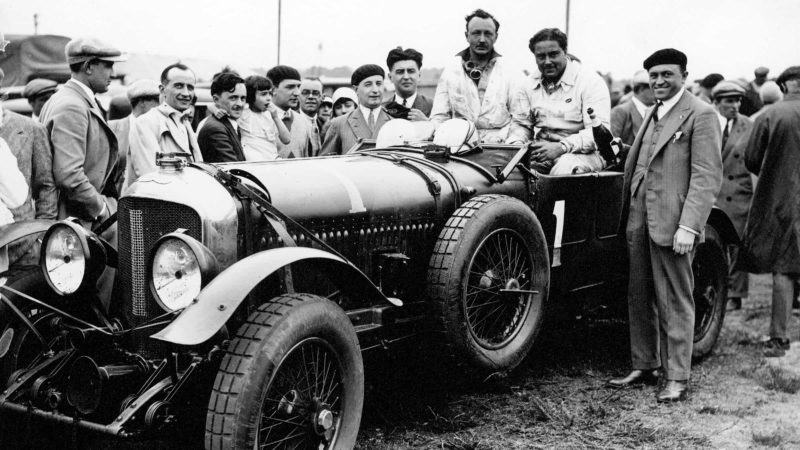Bentley's 4½-litre: A Tale of Endurance and Innovation
Bentley initially dismissed Le Mans as crazy but changed his view, leading to the 1927 win. The 4½-litre car with Barnato's support won in 1928.
Alamy
Car to remember
Bentley 4½
“I think the whole thing is crazy. Cars aren’t designed to stand that sort of thing for 24 hours.” That was W.O. Bentley’s reaction when John Duff planned to enter his 3-litre Bentley into the very first Le Mans. By 1924, when Duff’s Bentley came home first, W.O. had changed his view and the ACO’s endurance trial became a prime goal. After two disastrous Le Mans races it came right in spectacular style for 1927 when the battered 3-litre Old No 7 limped away from a spectacular pile-up to snatch an improbable victory. But it was clear that the experimental 4½-litre car, sidelined by the crash, had the speed Bentley needed for next year.
By 1928 Bentley had a guardian angel. Diamond millionaire Woolf Barnato baled out the sinking company and would prove a track hero, too. Race plans centred around boring out the four to 4½ litres, rather than the parallel six-cylinder range. The new 4½ produced 130bhp – and despite Bugatti’s comparing Bentleys to lorries, the race cars for the 1928 Le Mans only weighed around 1.7 tons.
The 16-valve overhead-cam engine apart, the 4½ was relatively conventional, but thanks to W.O.’s railway apprenticeship it was built like a locomotive. Andrew Frankel, Motor Sport’s chief test driver, has raced many of them: “They’re so wonderfully engineered – you could race and then drive home in.” And Bentley had an extra weapon: its cars were raced by wealthy sportsmen who brought to the marque a seductive image of carefree, debonair style: Bentley Boys were kings of the road.
In that 1928 race the strongest opposition came from the US, Barnato and Bernard Rubin tussling with the fastest Stutz and setting a new lap record. By Sunday afternoon the Bentley was leading – but overheating so badly that on the last lap Barnato coasted on the downhills. But he made it, first of a hat trick for the British marque. The following year a race version of the 6½ would win, but a trio of 4½s rounded out a Bentley 1-2-3-4, confirming it as the archetypal Le Mans Bentley, an image later fixed for thousands of small boys by Airfix and Scalextric. “Drivers preferred the 4½ – it was lighter on the nose, handled better and had a beautiful gearbox,” says Frankel. “Bentley winning five out of seven Le Mans put Britain on the racing map.”
Tim Birkin tried to keep the big four competitive with his supercharged ‘Blowers’, which in 1930 proved fast – but also fragile. That year would bring the last of Bentley’s five pre-war wins, and though it was another 6½ that triumphed, it’s the ‘bloody thump’ of the four that echoes loudest.
Stars of the decade
John Duff
War veteran, Hollywood stuntman, racer… Duff lived an extraordinary life. The first British Le Mans entrant in 1923, he won the next year for Bentley and is still the only Canadian victor.

André Rossignol
First driver to take back-to-back victories, in 1925 and ’26, and first (with Robert Bloch) to break a 100kph winning average. But Lorraine-Dietrich pulled out in 1927, leaving Rossignol high and dry.

Woolf Barnato
The most successful of the ‘Bentley Boys’, W.O. calling him “the best driver we ever had and the best British driver of his day. He never made a mistake.” He drove at Le Mans in 1928-30, winning all three.

Henry ‘Tim’ Birkin
Versatile and courageous, Birkin won Le Mans in 1929 with Bentley and in ’32 with Alfa. Mechanical failures robbed him of more success as he developed his supercharged Bentley.

The Winners
1923
Chenard & Walcker
André Lagache/René Léonard
2210km
Original 17.3km circuit runs through Pontlieue, used until 1928
1924
Bentley 3 Litre Sport
John Duff/Frank Clement
2077km
New rule stipulates that cars must cover 20 laps with hoods up
1925
Lorraine Dietrich B3-6
Gérard de Courcelles/André Rossignol
2234km
Famous Le Mans start first used
1926
Lorraine Dietrich B3-6
Robert Bloch/André Rossignol
2552km
First grandstands built and 100kph average achieved. Mulsanne Straight asphalted
1927
Bentley 3 Litre Super Sport
Dudley Benjafield/Sammy Davis
2370km
1928
Bentley 4½ Litre
Woolf Barnato/Bernard Rubin
2670km
1929
Bentley Speed Six
Woolf Barnato/Henry Birkin
2843km
Gallery

Eat my dust: The French Tracta Spéciale of Roger Bourcier and the singularly-named ‘Tribaudot’ leads Frank Clement/Jean Chassagne’s Bentley in 1929

The first appearance of a Peugeot works team came in 1926, with a 174S for Louis Wagner/Christian Dauvergne. It lasted 76 laps
Getty Images

The race start in 1928; safe to say the crowds are a fair bit bigger now. Barnato and Rubin would secure the victory for Bentley
Getty Images

Jean-Albert Gregoire and Lucien Lemesle dragged their Tracta to seventh place in the 1927 edition
Getty Images

Frank Clement and John Duff’s winning Bentley receives some attention in the pits in 1924. Bentley supported their efforts far more during this second attempt
DPPI

The 4.5-litre Bentley of Henry Birkin and Jean Chassagne passes the abandoned Lagonda 2 litre of Francis Samuelson and F King, which had crashed on lap 14 in 1928. Birkin/Chassagne went on to finish fifth
Getty Images

Woolf Barnato and Birkin’s Bentley at Le Mans in 1929. By this point the cars were being compared to lorries due to their immense proportions
Alamy

Barnato and Birkin pose after winning the 1929 Le Mans 24 Hours, with Barnato battling overheating to take the flag